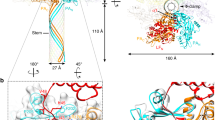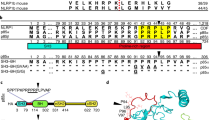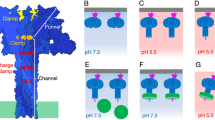Abstract
Anthrax toxin consists of the proteins protective antigen (PA), lethal factor (LF) and oedema factor (EF)1. The first step of toxin entry into host cells is the recognition by PA of a receptor on the surface of the target cell. Subsequent cleavage of receptor-bound PA enables EF and LF to bind and form a heptameric PA63 pre-pore, which triggers endocytosis. Upon acidification of the endosome, PA63 forms a pore that inserts into the membrane and translocates EF and LF into the cytosol2. Two closely related host cell receptors, TEM8 and CMG2, have been identified. Both bind to PA with high affinity and are capable of mediating toxicity3,4. Here, we report the crystal structure of the PA–CMG2 complex at 2.5 Å resolution. The structure reveals an extensive receptor–pathogen interaction surface mimicking the non-pathogenic recognition of the extracellular matrix by integrins5. The binding surface is closely conserved in the two receptors and across species, but is quite different in the integrin domains, explaining the specificity of the interaction. CMG2 engages two domains of PA, and modelling of the receptor-bound PA63 heptamer6,7,8 suggests that the receptor acts as a pH-sensitive brace to ensure accurate and timely membrane insertion. The structure provides new leads for the discovery of anthrax anti-toxins, and should aid the design of cancer therapeutics9.
This is a preview of subscription content, access via your institution
Access options
Subscribe to this journal
Receive 51 print issues and online access
$199.00 per year
only $3.90 per issue
Buy this article
- Purchase on Springer Link
- Instant access to full article PDF
Prices may be subject to local taxes which are calculated during checkout





Similar content being viewed by others
References
Moayeri, M. & Leppla, S. H. The roles of anthrax toxin in pathogenesis. Curr. Opin. Microbiol. 7, 19–24 (2004)
Abrami, L., Liu, S., Cosson, P., Leppla, S. H. & Vander Goot, F. G. Anthrax toxin triggers endocytosis of its receptor via a lipid raft-mediated clathrin-dependent process. J. Cell Biol. 160, 321–328 (2003)
Bradley, K. A., Mogridge, J., Mourez, M., Collier, R. J. & Young, J. A. Identification of the cellular receptor for anthrax toxin. Nature 414, 225–229 (2001)
Scobie, H. M., Rainey, G. J., Bradley, K. A. & Young, J. A. Human capillary morphogenesis protein 2 functions as an anthrax toxin receptor. Proc. Natl Acad. Sci. USA 100, 5170–5174 (2003)
Emsley, J., Knight, C. G., Farndale, R. W., Barnes, M. J. & Liddington, R. C. Structural basis of collagen recognition by integrin α2β1. Cell 101, 47–56 (2000)
Petosa, C., Collier, R. J., Klimpel, K. R., Leppla, S. H. & Liddington, R. C. Crystal structure of the anthrax toxin protective antigen. Nature 385, 833–838 (1997)
Benson, E. L., Huynh, P. D., Finkelstein, A. & Collier, R. J. Identification of residues lining the anthrax protective antigen channel. Biochemistry 37, 3941–3948 (1998)
Nassi, S., Collier, R. J. & Finkelstein, A. PA63 channel of anthrax toxin: an extended β-barrel. Biochemistry 41, 1445–1450 (2002)
Frankel, A. E., Koo, H.-K., Leppla, S. H., Duesbury, N. S. & Vande Woude, G. F. Novel protein targeted therapy of metastatic melanoma. Curr. Pharm. Des. 9, 2060–2066 (2003)
Lee, J.-O., Rieu, P., Arnaout, M. A. & Liddington, R. C. Crystal structure of the A-domain from the α subunit of integrin CR3 (CD11b/CD18). Cell 80, 631–635 (1995)
Lacy, D. B., Wigelsworth, D. J., Scobie, H. M., Young, J. A. & Collier, R. J. Crystal structure of the von Willebrand factor A domain of human capillary morphogenesis protein 2: An anthrax toxin receptor. Proc. Natl Acad. Sci. USA 101, 6367–6372 (2004)
Wigelsworth, D. J. et al. Binding stoichiometry and kinetics of the interaction of a human anthrax toxin receptor, CMG2, with protective antigen. J. Biol. Chem. 279, 23349–23356 (2004)
Shimaoka, M. et al. Structures of the αL I domain and its complex with ICAM-1 reveal a shape-shifting pathway for integrin regulation. Cell 112, 99–111 (2003)
Rosovitz, M. J. et al. Alanine scanning mutations in domain 4 of anthrax toxin protective antigen reveal residues important for binding to the cellular receptor and to a neutralizing monoclonal antibody. J. Biol. Chem. 278, 30936–30944 (2003)
Bradley, K. A. et al. Binding of anthrax toxin to its receptor is similar to α integrin-ligand interactions. J. Biol. Chem. 278, 49342–49347 (2003)
Mourez, M. et al. Mapping dominant-negative mutations of anthrax protective antigen by scanning mutagenesis. Proc. Natl Acad. Sci. USA 100, 13803–13808 (2003)
Miller, C. J., Elliott, J. L. & Collier, R. J. Anthrax protective antigen: prepore-to-pore conversion. Biochemistry 38, 10432–10441 (1999)
Petosa, C. in Crystal Structure of the Anthrax Protective Antigen. Thesis, Harvard Univ (1995)
Song, L. et al. Structure of staphylococcal alpha-hemolysin, a heptameric transmembrane pore. Science 274, 1859–1866 (1996)
Nanda, A. & St Croix, B. Tumor endothelial markers: new targets for cancer therapy. Curr. Opin. Oncol. 16, 44–49 (2004)
Nanda, A. et al. TEM8 interacts with the cleaved C5 domain of collagen alpha 3(VI). Cancer Res. 64, 817–820 (2004)
Liu, S., Schubert, R. L., Bugge, T. H. & Leppla, S. H. Anthrax toxin: structures, functions and tumour targeting. Expert Opin. Biol. Ther. 3, 843–853 (2003)
Otwinowski, Z. & Minor, W. Processing of X-ray diffraction data collected in oscillation mode. Methods Enzymol. 276, 307–326 (1997)
Collaborative Computational Project, No. 4. The CCP4 suite: programs for protein crystallography. Acta Crystallogr. D 50, 760–763 (1994)
Jones, T. A., Zou, J.-Y., Cowan, S. W. & Kjelgaard, M. Improved methods for building protein models into electron density maps and the location of errors in these models. Acta Crystallogr. A 47, 110–119 (1991)
Morris, R. J., Perrakis, A. & Lamzin, V. S. ARP/wARP and automatic interpretation of protein electron density maps. Methods Enzymol. 374, 229–244 (2003)
Brunger, A. T. et al. Crystallography & NMR system: A new software suite for macromolecular structure determination. Acta Crystallogr. D 54, 905–921 (1998)
Lee, J.-O., Bankston, L. A., Arnaout, M. A. & Liddington, R. C. Two conformations of the integrin A-domain (I-domain): a pathway for activation? Structure 3, 1333–1340 (1995)
Sanner, M. F., Olson, A. J. & Spehner, J. C. Reduced surface: an efficient way to compute molecular surfaces. Biopolymers 38, 305–320 (1996)
Acknowledgements
We thank the NIH and the DOD for financial support, and the DOE and staff at the SSRL for synchrotron access and support.
Author information
Authors and Affiliations
Corresponding author
Ethics declarations
Competing interests
The authors declare that they have no competing financial interests.
Rights and permissions
About this article
Cite this article
Santelli, E., Bankston, L., Leppla, S. et al. Crystal structure of a complex between anthrax toxin and its host cell receptor. Nature 430, 905–908 (2004). https://doi.org/10.1038/nature02763
Received:
Accepted:
Published:
Issue Date:
DOI: https://doi.org/10.1038/nature02763
This article is cited by
-
Targeting Bacillus anthracis toxicity with a genetically selected inhibitor of the PA/CMG2 protein-protein interaction
Scientific Reports (2017)
-
Molecular assembly of lethal factor enzyme and pre-pore heptameric protective antigen in early stage of translocation
Journal of Molecular Modeling (2016)
-
Atomic structure of anthrax protective antigen pore elucidates toxin translocation
Nature (2015)
-
Identification and characterization of multiple rubisco activases in chemoautotrophic bacteria
Nature Communications (2015)
-
The dark sides of capillary morphogenesis gene 2
The EMBO Journal (2012)
Comments
By submitting a comment you agree to abide by our Terms and Community Guidelines. If you find something abusive or that does not comply with our terms or guidelines please flag it as inappropriate.



